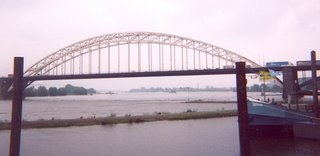Keukenhof: Kitchen Gardens
Lisse
Tulips arrived in the Netherlands in the 1600's, courtesy of the Ottoman Empire. The flower had been wild, cultivated by the Turks as early as 1000 AD. The name recalls the shape of a turban, see http://www.holland.nl/uk/holland/sights/tulips-history.html.
Update 2015: a video on mechanized tulip bulb harvesting in The Netherlands, see http://www.youtube.com/embed/wZ5MAr7d-5Y?rel=0
If possible, time your visit to the Netherlands for tulip time, in May. These fabulous and vast gardens close in July for maintenance and tidying up. Most everything is tulips there, and tulips have a limited bloomsday. See slide show at http://www.keukenhof.nl/. Keukenhof is a public garden -- there since 1949, and now nurtures some 6 million bulbs, says our guidebook. Another book says that some 7 million bulbs bloom each year. Area: 32 hectares. What is that? A hectare is about 2.47 acres, see http://en.wikipedia.org/wiki/Hectare, So: somewhat less in area than 92 acres?
 Keukenhof Gardens, tulips, Lisse, the Netherlands
Keukenhof Gardens, tulips, Lisse, the NetherlandsEven in the rain, the colors are spectacular. Winding, wide walkways, and varieties unimagined.
Arrival in the mist or light rain is fine. A downfall of rain, however, would probably cause the petals to drop. We came almost directly from the airport, in case of heavier rains to come.
 Keukenhof. Tulip fields, Lisse, the Netherlands
Keukenhof. Tulip fields, Lisse, the NetherlandsThe choice is to head in another direction, and hope for better weather when you return. Seize the day.
Some tulips are past knee-high, and even reach hip-height. Some were up to Dan's waist in some areas. Long, long stems. See http://www/europeforvisitors.com/europe/articles/keukenhof_gardens.
There are well-spaced and spacious rest areas in the gardens, with food, facilities, but note where you came in. It is easy to get lost. This is a really big place. It was once the hunting grounds of the Teylingen Estate, see 15th Century Countess Jacqueline of Wittelsbach at http://www.keukenhof.nl/images/fck/File/KKH,%20sixty%20years%20as%20the%20paragon%20of%20beauty.pdf
 Dan Widing at Keukenhof Gardens, Lisse, The Netherlands. Hip-high tulips. Not a raised bed.
Dan Widing at Keukenhof Gardens, Lisse, The Netherlands. Hip-high tulips. Not a raised bed. Nijmegen, Bridge, Operation Market Garden, the Netherlands
Nijmegen, Bridge, Operation Market Garden, the Netherlands Bridge at Nijmegen, view with The Hotel Courage right there
Bridge at Nijmegen, view with The Hotel Courage right there Operation Market Garden tribute sculpture, Nijmegen, the Netherlands
Operation Market Garden tribute sculpture, Nijmegen, the Netherlands VE Day, 60th Anniversary Parade, Nijmegen, the Netherlands
VE Day, 60th Anniversary Parade, Nijmegen, the Netherlands Canadian War Cemetery, Military Piper and Dan Widing, Grosbeek, the Netherlands
Canadian War Cemetery, Military Piper and Dan Widing, Grosbeek, the Netherlands Canadian Guardsman, Grosbeek Canadian Military Cemetery, NL
Canadian Guardsman, Grosbeek Canadian Military Cemetery, NL Kinderdijk, windmill, the Netherlands
Kinderdijk, windmill, the Netherlands Working windmill with sails, near Kinderdijk NL
Working windmill with sails, near Kinderdijk NL Windmill row, Kinderdijk, the Netherlands
Windmill row, Kinderdijk, the Netherlands Polder, or drained farm land. See mast of boat at eye level, canal across the field, near Kinderdijk NL
Polder, or drained farm land. See mast of boat at eye level, canal across the field, near Kinderdijk NL Madurodam Miniature Village, Scheveningen, near the Hague, NL
Madurodam Miniature Village, Scheveningen, near the Hague, NL Scale of miniature village, Madurodam, NL
Scale of miniature village, Madurodam, NL